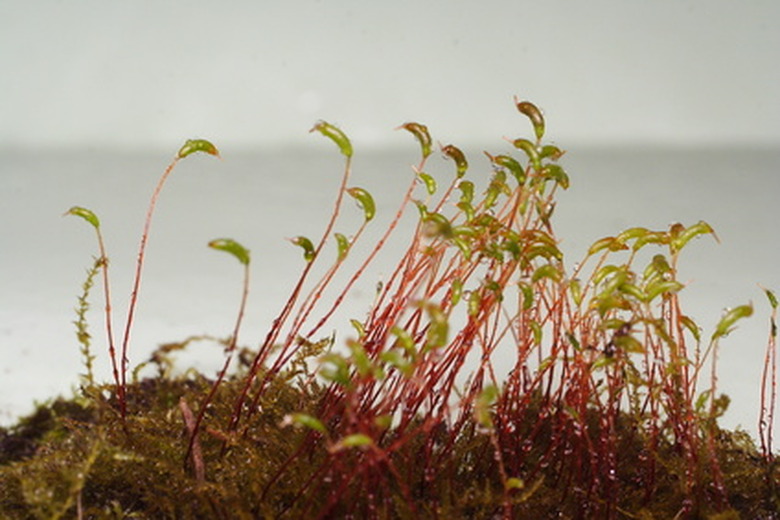Sphagnum Vs. Spanish Moss
Confusion may arise when florists and horticulturists drop the terms "sphagnum" and "Spanish moss" in conversations about growing houseplants or improving soil. Sphagnum, also called sphagnum moss, slowly decomposes to form a soil amendment called sphagnum peat or peat moss. Spanish moss isn't a moss at all and grows in a completely different environment, with different needs and growth habit.
Origins
Sphagnum comprises any number of true mosses that belong to the botanical genus Sphagnum. It grows in cool, moist to wet marshes, bogs or wetlands where winter freezes occur. As the plants grow, their dead leaves and stems form a compost peat mat that sustains more new moss plants.
Spanish moss is a bromeliad (Tillandsia usneoides) that grows upon and dangles from tree branches in tropical and subtropical regions. It is not a true moss but a flowering plant.
- Confusion may arise when florists and horticulturists drop the terms "sphagnum" and "Spanish moss" in conversations about growing houseplants or improving soil.
- Sphagnum comprises any number of true mosses that belong to the botanical genus Sphagnum.
Identification
Sphagnum moss grows low to the ground in tufted clumps of stems and tiny leaves that are light green although some species have pink, bronze, yellow or reddish foliage. It grows no taller than 4 inches but spreads to potentially more large colonies to look like a groundcover.
Spanish moss is an epiphyte–growing upon another plant like a tree–and has a long string of thin, hair-like leaves that are silvery green. A individual strand eventually branches and becomes a mop-like clump of foliage that produces tiny chartreuse flowers, which are usually overlooked. Strands can be as long as several yards in length.
Features
When actively growing, sphagnum does look like a moss and when dried retains a green to brown color. The plant parts soak up water and hold it well. Likewise, if the dried sphagnum is allowed to further decay and become compacted, it becomes sphagnum peat. Peat is soil-like organic matter that is acidic in pH, retains moisture and is a dark red-brown to chocolate brown in color.
- Sphagnum moss grows low to the ground in tufted clumps of stems and tiny leaves that are light green although some species have pink, bronze, yellow or reddish foliage.
- When actively growing, sphagnum does look like a moss and when dried retains a green to brown color.
Spanish moss resembles a stringy lichen or fungus. When it is wet, its color changes to light green but then dries to gray or silvery green. Excessive dryness kills Spanish moss, when it shrivels up slightly and becomes grayish brown in color. It does not retain moisture when wet but dries out; it will rot and decompose if kept too wet.
Function
Sphagnum is typically sold in packages to use as a decorative soil-top dressing on indoor container plants or to line hanging wire baskets. It is also used as a naturalistic craft product for model train set environments, creches or statuary, or as a groundcover in a terrarium. Decomposed sphagnum is sold as peat or peat moss and is used as a soil conditioner to improve the texture, drainage or moisture content of top soils. It is also used as a primary component in soil-less potting mixes for houseplants or to sow seeds.
- Spanish moss resembles a stringy lichen or fungus.
- Decomposed sphagnum is sold as peat or peat moss and is used as a soil conditioner to improve the texture, drainage or moisture content of top soils.
Spanish moss traditionally was used to stuff mattresses, life preservers and automobile seats, according to Floridata. Today Spanish moss is used (when dried) as a top dressing on interior container plant or as a craft product, just like sphagnum. Spanish moss does not decompose to become a soil amendment.
Concerns
The Canadian Sphagnum Peat Moss Association recognizes that sphagnum moss grows in limited natural areas and thus a primary concern is the preservation of habitat while also ethically harvesting the moss and underlying layers of peat. It takes decades for sphagnum to renew into large, deep ecosystems. Today in Canada and the United States there are many producers of sphagnum and peat that harvest materials in order for it to be a more renewable resource.
Spanish moss is widespread across much of the frost-free land of North America and is not in low supply. Since Spanish moss is easily obtainable when it drops from trees, it contains many small insects and other creatures in its foliage mass. Floridata comments that before the plant material is brought indoors or used, it should be microwaved or boiled in water to kill the plant and anything hiding or living within it.
- Spanish moss traditionally was used to stuff mattresses, life preservers and automobile seats, according to Floridata.
- The Canadian Sphagnum Peat Moss Association recognizes that sphagnum moss grows in limited natural areas and thus a primary concern is the preservation of habitat while also ethically harvesting the moss and underlying layers of peat.
